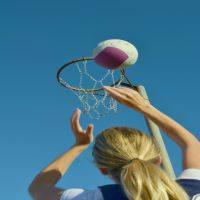Across England, as in many other countries, an age-related decline in physical activity has been found in many studies and is a challenge which physical education teachers are trying to overcome.
According to Telama and Yang (2000), physical activity is shown to dramatically decline during adolescence, particularly among girls from the age of 12. The study suggests that there are many barriers to girls’ participation in sport such as lack of time; involvement in technology-related activities; influence from peers, parents and teachers; ability comparison and appearance concerns.
If we want to build on the success of the London 2012 Olympics and continue the British sporting legacy, it is vital that PE teachers are aware of these barriers in order to plan various strategies of intervention to help raise girls’ involvement in sport.
Askew & Ross (1988) suggest that certain role models portrayed through the media influence the attitudes and beliefs of young children, who are inspired to conform to the same attitudes and beliefs as their role models, with many young boys aspiring to be the next ‘Christiano Ronaldo’.
It is no secret that sportswomen are under-represented in the media and when compared to the amount of exposure that female celebrities such as pop stars, actresses and models receive – the influence they have on young females is no surprise.
In England, the spectrum of media forms by which a teenage girl can be influenced in just one day can amount to many hours when considering the amount of time spent:
- Watching TV
- Listening to music
- Watching movies
- Reading magazines
- Using the internet
The images these young girls are shown inevitably affect the way they are seen by others and themselves. And, in an age when childhood obesity is a contemporary issue, students’ self esteem and their perceptions of body image could contribute to the decline of girls’ participation in sport due to some girls not wanting to get changed in front of their peers or not wanting to get ‘sweaty’. This can result in them not choosing to participate in extra-curricular sports teams or clubs.
The rise of computers and social network sites have made it easy for children to be entertained and socialise without ever leaving the comfort of their bedroom and I believe that PE teachers have an increasingly difficult battle to engage children actively with so many sedentary distractions.
In order to raise the participation of girls in sport, I believe it is imperative that teachers capture the interest of young girls through outstanding lessons which inspire, enthuse and engage children.
If students are being ‘hooked’ on sport through outstanding teaching which caters to the needs of every student regardless of their ability, then it could be argued that the barrier of ability comparison could be overcome.
If girls feel more at ease when working with and alongside their peers, then they may feel more inclined to stay active and remain in sport.
As well as outstanding lessons, I believe that it is equally important to deliver a curriculum that meets the needs of each student. From experience, one strategy that I have personally found effective, is giving students a voice through questionnaires, student council meetings or speaking to classes or groups of students directly to ensure that their PE curriculum is one they want to ‘buy’ into.
From a dialogue with a specific group of disengaged girls, it was discovered that they were not in favour of traditional competitive sports. However, they were very interested in activities such as Zumba and Cheerleading. Once re-engaged in physical activity, they were also interested in attending these activities as part of an extra-curricular programme with some then competing at the West Yorkshire Youth Games.
Another strategy which has been found to be effective in engaging girls in competitive sport is educational sports trips such as Netball, Skiing and Rugby League trips nationally and overseas – to inspire and encourage students. It is these deep learning experiences which capture the interest of young girls and will help to keep them participating in sport into their adult lives.
I believe one of the most important ways to engage girls in participating in sport is to give them enough opportunities through a variety of extra-curricular sports clubs and teams along with time, commitment and dedication.
There are many potential barriers that could prevent girls from participating in sport, but I believe that these barriers can be overcome by reflecting on the current provision being delivered and by looking at how it can be improved.
Change, whether it is in the form of a different curriculum programme or an increase in extra-curricular opportunities, can be the catalyst to drive increased participation by matching their expectations and wants with what is offered.
If change is needed to increase participation then you should implement change in consultation with the students. As Henry Ford said, “If you always do what you’ve always done, you’ll always get what you’ve always got.”









